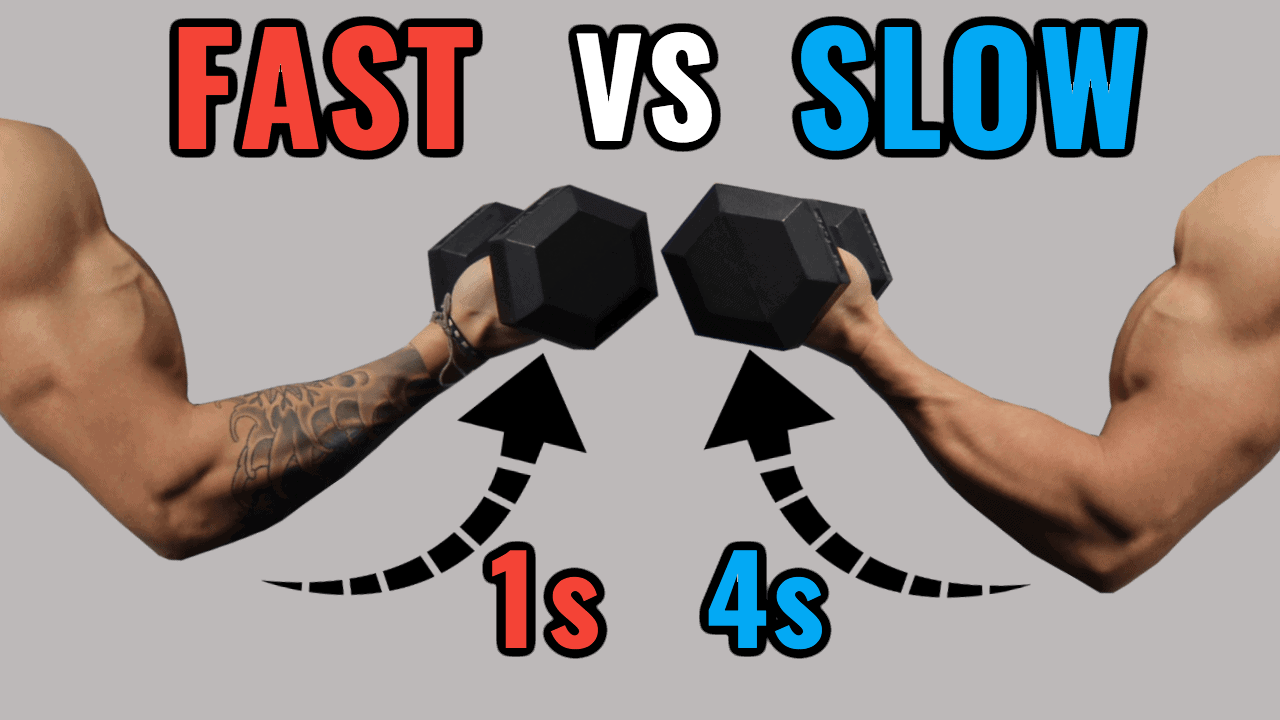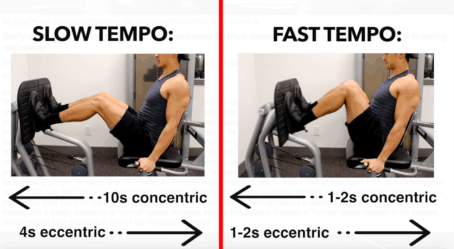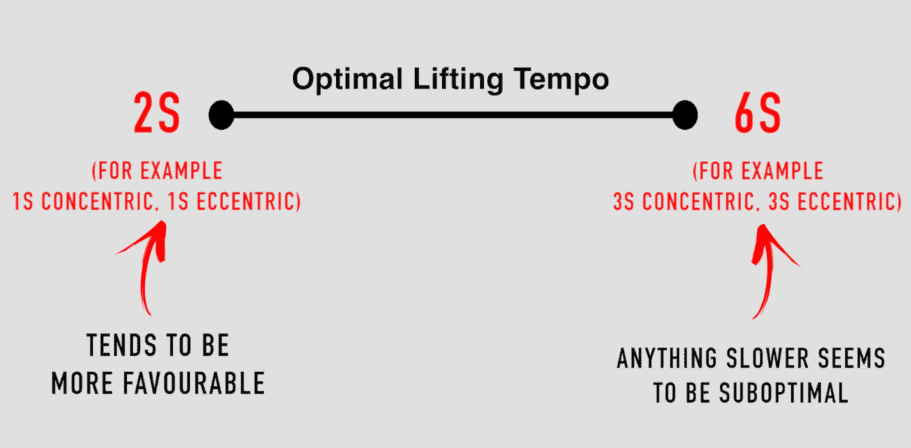Slow Reps vs Fast reps: Which is Better for Muscle Growth
If you want to learn what science has to say about the "slow reps vs fast reps" debate, then you need to read this article.
When it comes to training for muscle growth, there’s a lot of program variables that need to be considered. But one often overlooked variable is lifting tempo; how fast you perform each repetition.
You’ve probably noticed that some people in the gym tend to perform their reps as fast as possible, whereas others take a slow and controlled approach.
But which approach is better in terms of muscle growth? Well to answer this, let’s first take a more in depth look at each approach.
Before that: if you're looking for a training program that'll always help you train in the most optimal approach for muscle growth, I've got just the thing for you. Every BWS program is designed to help you transform your physique in the most time-efficient manner. And best of all? It's all rooted in science. For more information on how BWS programs can help you to look better - FAST:
Click the button below to take my analysis quiz to discover the best program for you:
↓
The Benefits of Using Slow Reps for Muscle Growth
The main benefit of lifting with a slower lifting tempo is that you achieve a greater time under tension. This simply means that your muscle is under strain for a longer period of time throughout the set.
And since a greater time under tension is generally associated with an enhanced metabolic response, this theoretically leads to greater muscle growth.
The Benefits of Using Fast Reps for Muscle Growth
On the other hand, the main benefit of lifting reps at a faster tempo is that you can perform more reps or use a heavier weight than you can with a slower tempo.
So as some of you might be able to tell, it becomes a competition between time under tension versus the amount of reps/weight used. But which comes out on top?
Well, it seems that although time under tension is reduced with a faster tempo, this actually doesn’t hinder muscle growth.
One 2012 study by Herman and colleagues compared "super slow" reps (10s concentric and 4s eccentric) with faster reps (1-2 second concentric and eccentric) on various lower body exercises.
Slow Vs. Fast Tempo
Despite having an almost five-fold greater time under tension for the slow group, they only experienced an 11% increase in quadriceps muscle size compared to a 39% increase in the faster tempo group.
Although I'll admit this is an extreme example given the unrealistically slow tempo that was used, it helps illustrate the fact that time under tension isn’t the most important factor regarding muscle growth. In addition, the ability to lift heavier loads by using a faster tempo enables a greater overall recruitment of muscle fibers (specifically type 2 muscle fibers). This leads to greater overall activation of the target muscle.
One study from the Journal of Strength and Conditioning Research showed that when a slow lifting tempo and lighter weight was used (5s concentric and 5s eccentric, 55% 1RM), activation of the chest was reduced by up to 36% during the bench press when compared to lifting with a faster tempo and heavier weight (subjects instructed to lift as fast as possible with 85% 1RM).
And this was seen despite both protocols being taken to failure, indicating that very slow lifting fails to sufficiently stimulate or activate the higher threshold type II muscle fibers.
So as you can see, a slower tempo results in less overall muscle activation and presumably less growth of the target muscle.
How Fast Should You Go?
So we know that faster reps are probably better in terms of muscle growth. But exactly how fast should you be aiming for?
Well a recent 2016 meta-analysis by Schoenfeld and colleagues provides some insight. They found that based on all of the studies currently published on lifting tempo (which to be honest is quite limited) a lifting tempo between 2 to 6 seconds per rep seems to maximize growth.
Optimal Lifting Tempo
They also found that tempos closer to 2 seconds are slightly more favourable than 6 seconds. Anything slower than 6 seconds (and especially past 10 seconds) seems to be suboptimal in terms of muscle growth.
But with that being said, I’d advise you not to obsess over the exact numbers regarding your lifting tempo and instead use the following advice.
We know based on experience, anecdotal accounts, AND research that a solid mind to muscle connection plays an important role in muscle growth.
We also know that controlling the eccentric portion of the lift seems to lead to greater muscle and strength gains while decreasing the risk of injury when compared to simply letting gravity do the work for you.
Therefore, the best way to approach lifting tempo would be to:
- Use a concentric speed that’s on the faster side but still enables you to feel your muscle working throughout the movement.Whether this is 1 second or 2 seconds for example will completely depend on what feels best for you.
- Perform the eccentric portion of your reps so that you’re actively controlling the weight against gravity as opposed to simply dropping the weight
Utilizing these two tips will help you get the most out of your lifting tempo while keeping things simple and easy to implement.
Of course, your lifting tempo is going to change based on the exercise you're performing. If you wish to get more guidance on this, don't worry. Our 3-on-1 coaching program can help. I and my team are going to personally determine the lifting tempo most suitable for you and your selection of exercises - helping you achieve your dream physique. Sounds good? Let's get started then:
Click the button below to find out more about the 3-on-1 coaching program:
↓
Limitations of Slow Vs Fast Reps
The advice I've previously suggested does come with its limitations.
First off, lifting tempo becomes less applicable when you’re using heavy weight. For example, if you’re lifting close to your 1RM, your reps are by default going to be relatively slow regardless of if you were trying to perform them as fast as possible. So only when the load is lightened is when you have a lot more control over your lifting tempo. Thus, for your heavy compound movements, lifting tempo is more "one size fits all" but you still want to control the eccentric!
Secondly, this article was mainly geared towards muscle growth as opposed to strength gains. The ideal lifting tempo for powerlifters or those more concerned with strength gains will differ. Research shows that for strength gains, trying to move the bar/weight as fast as possible is likely the best option. Powerlifters and such are also usually less concerned with developing a solid mind to muscle connection during their lifts and more so just want to get the weight up. So basing their lifting tempo on what helps them best establish a solid mind to muscle connection wouldn't be the best option in their case.
Finally, there’s definitely a lot more research that needs to be done regarding the fast reps vs slow reps debate. But I do think there’s enough for a general conclusion to be made. Hopefully the tips mentioned in this article helps clear up some of the questions/concerns you had regarding lifting tempo and its affects on muscle growth!
And for those looking for a complete step-by-step program that uses science to show you how to properly train AND eat week after week to transform your body in the most efficient and injury-free way possible, then:
Click the button below to take my analysis quiz to discover the best program for you:
↓
By the way, here’s the article summed up into a YouTube video:
Feel free to let me know if you have any questions down below. And give me a follow on Instagram , Facebook , and Youtube where I'll be posting informative content on a more regular basis. Cheers!











